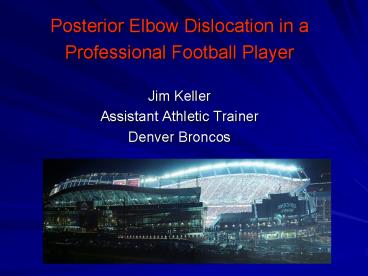Posterior Elbow Dislocation in a PowerPoint PPT Presentation
1 / 28
Title: Posterior Elbow Dislocation in a
1
- Posterior Elbow Dislocation in a
- Professional Football Player
- Jim Keller
- Assistant Athletic Trainer
- Denver Broncos
2
Thanks to the Following Steve Antonopulos
A.T.,C Ted Schlegel MD Corey Oshikoya
A.T.,C Charlie Ho MD Kathy Paniello RN
84
3
Case Study
- 34 yr old tight end/13th season
- Tackled posterior lateral force
- Hyperext/valgus mechanism
- R Elbow Subluxation/Dislocation?
- Spontaneous reduction
- Removed field/game
- X-Ray, compression/sling
- Rehab 11/12/03, post MRI
- R Elbow simple post. dislocation
- 11/27/03 Practice (16 Days)
- 12/08/03 Game (27 Days)
4
- Unlike the shoulder, the elbow joint is
inherently stable because of the anatomy of the
articulation. Elbow dislocations are usually a
high energy episode with severe soft tissue
injury. Residual loss of motion is common but
recurrent instability is rare.
ODriscoll et al(1990)
5
(No Transcript)
6
(No Transcript)
7
(No Transcript)
8
(No Transcript)
9
MRI Results
- Disruption of the anterior capsule with 2-3cm
defect of distal brachialis with extensive
hemorrhage and fluid. - Tearing/stripping of the anterior bundle of the
medial collateral ligament complex, distally
greater than proximal - High grade partial tearing of the common flexor
tendon at medial epicondyle and hemorrhage within
the flexor pronator musle mass. - Large joint effusion with multiple internal
bodies.
10
(No Transcript)
11
(No Transcript)
12
Simple vs Complex Dislocations
- Complex Dislocation A more complex injury
involving injury to both bones and ligaments in
the joint. Usually resulting in instability of
the joint and may require surgical intervention. - Simple Dislocation A dislocation producing soft
tissue damage to the surrounding joint. Most
often instability is not an issue and therefore
can be treated through rehabilitation. - Hildebrand et al (1999)
13
Mechanism of Injury
- Result of hyperextension most commonly from a
fall. Anatomically the olecranon impinges in the
olecranon fossa levering the trochlea over the
coronoid process. - Andrew et al(2002)
- Combination of axial compression, elbow flexion
valgus stress and forearm supination creating a
rotational displacement of the ulna on the
humerus. - ODriscoll et al(1992)
14
Surgery vs Treatment
- There is clear consensus that the best results
following a simple posterior dislocation are
conservative treatment, with early aggressive
movement and minimal immobilization. The
rehabilitation protocol attempts to restore early
range of motion, regain full function and
decrease time loss. - 1. Unstable elbows (require more than 60 degrees
of flexion to stay reduced). The instability
is most often due to a fracture - 2. Competitive throwers (especially pitchers).
High stressed placed on the medial elbow during
cocking and acceleration phase of throwing. - Andrews et al (2002)
15
NFL Injury Analysis
- 64 Elbow Dislocations
- 22 NFL Seasons
- Average time loss is 38 days
- Median time loss is 30 days
- All 64 dislocations occurred during a game
- 1 case surgery was performed
- Powell (SIMS)
16
3 Simple Posterior Dislocations
- Case 1 (2002) TE
- R Elbow dislocation
- Return to practice 16 days
- Return to game 27 days
- Case 2 (2000) WR
- L Elbow dislocation
- Return to practice 29 days
- Return to game 35 days
- Case 3 (2000) DB
- R Ebow dislocation
- Injured reserve 48 days
- Clav Fx, eye abrasion, R hamstring L gamekeeper,
R bennetts fx
17
Rehabilitation Protocol
18
Cornerstones of Rehab Program
- Hinged Brace/Compression
- NSAIDS
- Ice and Elevation
- Early aggressive PROM avoiding unstable extension
and pain - Rehab is not a cookbook
- Communicate with athlete
- Soft tissue massage techniques
- Working entire kinetic chain
- Stabilization exercises
- Custom fit functional brace upon return
19
Bracing
- Hinged Brace
- Set ROM limitations
- Allows for compression
- Able to sleep in brace
- Allows rehab to begin
- Long term Immobilization
- Unable to rehab early
- Adhesions, fibrosis, contractures
- Shortening anterior capsule
- Intra-articular adhesions and stiffness,
decreasing ROM - Melhoff et al (1987)
20
- Passive ROM (2 Days)
- Active ROM (5 Days)
- Hydro therapy (6 Days)
- Stretching (5 Days)
- Early protected ROM promotes healing of the bone
and articular cartilage, increases tensile
strength of soft tissue and minimzes adhesion
formation, that cause stiffness. - Hunter et al(2002)
21
- Efflurage (2 Days)
- Soft tissue massage (4 Days)
- Myofascial release (5 Days)
- ART (21 Days)
- MAT (16 Days)
- Techniques are used to decrease inflammation,
increase mobilization, mechanically stretch the
skin, fascia and muscle tissues to help restore
normal joint motion and kinematics. - Hunter et al(2002)
22
- Sport cord Bicep/tricep wrist (10 Days)
- Sport cord Shoulder (12 Days)
- Manual resistance wrist, bicep/tricep (7 Days)
- Manual resistance shoulder (9 Days)
- PNF (Did not perform)
- Weight room bicep/tricep (12 Days)
- Weight room upper body modified (19 Days)
23
- Closed chain seated (8 Days)
- Closed chain standing (9 Days)
- Closed chain quad/tripod (11 Days/15 Days)
- Closed chain uneven surface (14 Days)
24
- Body blade (DNP)
- Ball stabilization (5 Days) for sit-ups/lower
extremity - SS stance (12 Days)
- SS running (12 Days)
- SS blocking (12 Days)
- SS catching (10 Days)
25
Custom Fit Brace
- ROM limitations
- Custom fit to individual
- Provides stability
- Protects from trauma
- Compact size
- Increases confidence
26
Transitional Rehabilitation
- Continue pain modalities
- Light A/P mobs
- Scale back amount of resistive exercises in TR
- Increase progression in weight room
- Keep on the field/happy medium
- Adapt bracing as needed
- Pad opposite elbow
27
Conclusions from case study
- Complete and early diagnosis
- Compliant driven athlete
- Short immobilization with early rehab
- Accelerated rehab protocol
- Ability to adjust
28
Thank You for your time!

